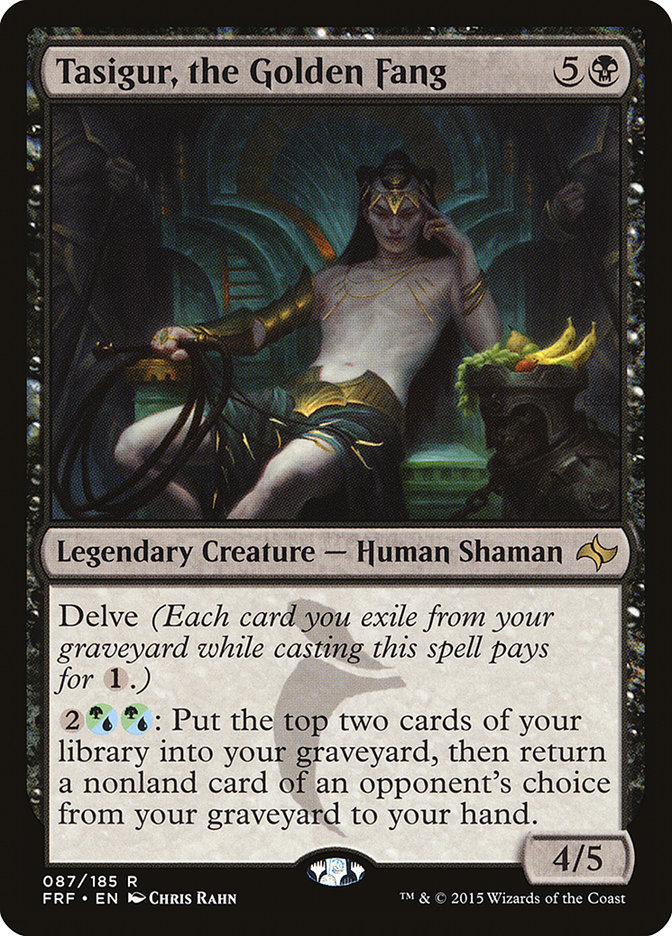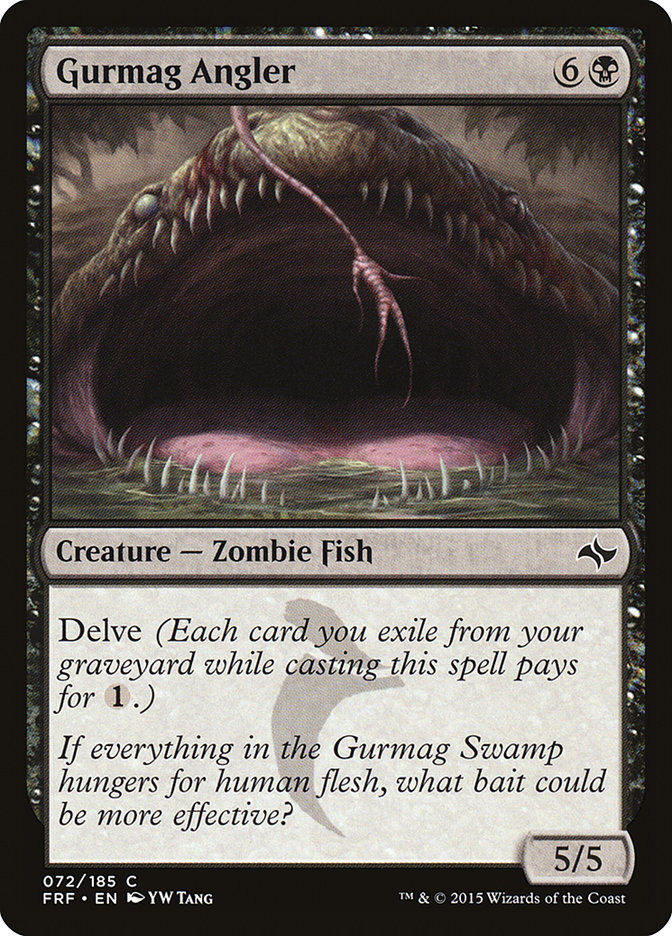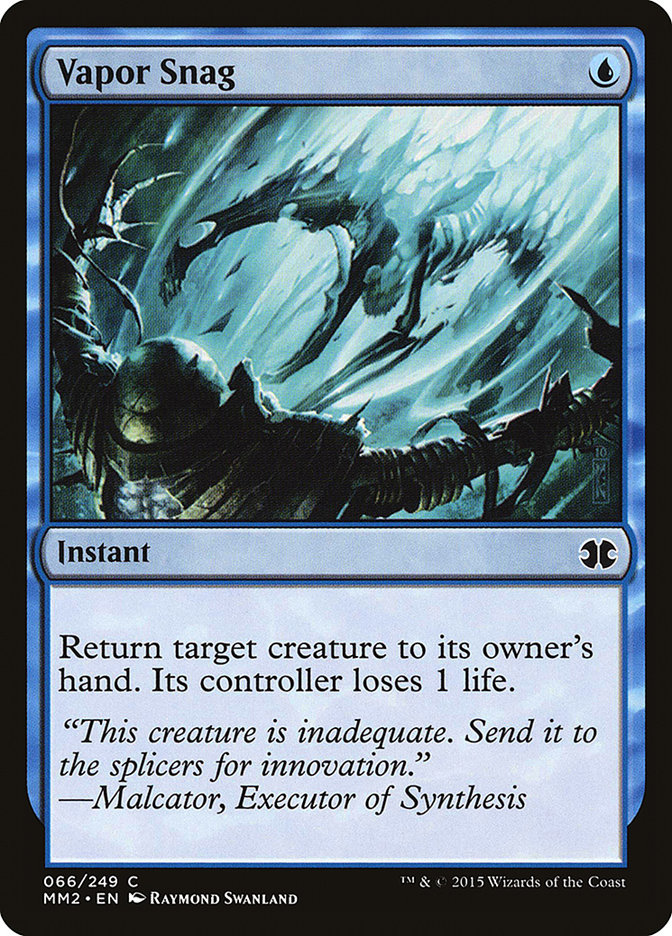If you aren’t abusing mana-cheating effects in Modern, you’re doing it
wrong. Last weekend#SCGCHAR showed us that Death’s Shadow isn’t completely unbeatable, but
it’s hard to do it while playing fair.
Looking at the
decks in the Top 8
, every single one of them is cheating on mana in a big way, with Death’s
Shadow somehow being the smallest offender. Eldrazi Tron, Dredge,
Living End, and Grixis Death’s Shadow made up the entirety of the
elimination rounds; when we take into account the direction that Magic has
been headed for the last few years, it isn’t shocking that their common
denominator is rooted in on-board advantages.
Flashback to the first Innistrad‘s release. Todd Anderson may not
have realized it at the time, but he set into motion the biggest shift in
Magic strategy that we’ve seen since. At the time, card advantage was king
and cards like Squadron Hawk and Jace’s Ingenuity were seeing significant
amounts of play. Todd said “no more,” and threw a heck of a curve ball:
Creatures (21)
- 4 Phantasmal Bear
- 4 Lord of the Unreal
- 4 Phantasmal Image
- 1 Stitched Drake
- 4 Snapcaster Mage
- 4 Delver of Secrets
Lands (20)
Spells (19)
Sideboard

His
first article
on the deck makes it appear that the idea was mostly an accident, but the
entire format ended up warping around this type of strategy, until it
became what is remembered as one of the best decks in the modern era.
Creatures (15)
Lands (21)
Spells (24)

Believe it or not, there was a time when playing Vapor Snag was laughable
and it was debatable whether or not it was worth registering for a
tournament. Times have changed.
Creatures (18)
Planeswalkers (2)
Lands (24)
Spells (16)

Starting off with Todd Stevens’ winning list, almost every land in this
deck has the opportunity to tap for multiple mana within a turn, and a host
of amazing cards to take advantage of that.

Normally, playing cost-prohibitive cards in Modern is a recipe to get
cheesed out by the likes of Burn, Counters Company, or a wide range of
other linear decks that the format boasts. Eldrazi Tron has the benefit of
attacking this from multiple angles.
The key to Eldrazi’s disruption is that a healthy chunk of its interactive
spells are tacked onto its creatures.
Both of these cards are examples of threats that can keep what the opponent
is doing in check while also applying pressure. This means that in games
where the opponent has a reasonable draw, picking through their best cards
is going to make the game manageable, and close the door in games where the
opponent may be floundering.
Older Tron decks had the perfect Expedition Map curve that involved playing
Tron piece number one on the first turn and casting Expedition Map, playing
the second Tron piece on the second turn and cracking Expedition Map for
the third piece. This deck doesn’t have to draw multiple unique pieces of
Tron in order for it to cheat on mana. Expedition Map can act as a way to
grab Eldrazi Temple and crank out a Thought-Knot Seer on the third turn of
the game. Between those draws and Mind Stone, cranking out early copies of
Thoughtseize-meets-Loxodon Smiter is remarkably easy.
It’s entirely possibly that Eldrazi Tron is the best deck in the format. If
it is, it’s due to the fact that it has the most consistent engine to cheat
on its mana in the format. The difficulty to disrupt it just gives the deck
more points.
Creatures (16)
Lands (19)
Spells (25)

Most of what there is to say about Grixis Death’s Shadow has already been
written about on this website, but stay with me. Why was Tarmogoyf heralded
as “the best creature ever printed” for such a long time?
There isn’t anything particularly flashy about it. Nothing except
efficiency, that is. Despite not having abilities, Tarmogoyf pushed the
boundaries of what the casting cost for a threat could be. This is how it
was able to stay on top for so long: despite effectively being a vanilla
creature, Tarmogoyf was just huge for the amount of mana (read:
time) invested into it.
When today’s midrange-flavor of Death’s Shadow burst onto the scene, it was
a Jund deck that used Death’s Shadow alongside Tarmogoyf.
Creatures (12)
Planeswalkers (4)
Lands (18)
Spells (26)

Both of these decks are trying to do something simple; gain advantages at
the expense of the resource that each player has the most of: life.
The most common jab that people will make at this archetype is something to
the effect of “Oh sure, the deck’s totally fair. Just as fair as a 9/9 for
a single black can be!” The power of the archetype lies in the fact that
almost everything costs a single mana.
A large draw to the Grixis version of Death’s Shadow over Jund is in the
delve threats.
Delve was a mistake. I’m not the first person to say it and I won’t be the
last.
Delve’s ability to hyper-inflate spells’ converted mana costs makes them
unreasonably powerful due to their resiliency to cards that are meant to
compete on the axis that they fight on.
Despite Grixis Death’s Shadow having no trouble playing Gurmag Angler or
Tasigur, the Golden Fang on the second or third turn, zero of these cards
have the ability to touch them:

It’s unbelievable that there was a time in playtesting Grixis Death’s
Shadow for #SCGCHAR
that I considered the benefits of Disdainful Stroke against a deck that
doesn’t pay more than three mana for any of its spells.
The fact that Death’s Shadow and Eldrazi Tron can both tap two lands for
cards that can’t be Inquisition of Kozileked or Abrupt Decayed is
incredibly powerful. I’d go as far as to say problematic, but that’s an
entirely different discussion.
Creatures (30)
- 4 Simian Spirit Guide
- 4 Street Wraith
- 4 Faerie Macabre
- 2 Fulminator Mage
- 4 Architects of Will
- 4 Monstrous Carabid
- 4 Desert Cerodon
- 4 Horror of the Broken Lands
Lands (18)
Spells (12)
Sideboard

Living End is likely the biggest offender in the format as far as decks
that abuse their mana go. For every mana it spends cycling, it will later
gain between four and six mana in the form of creatures being put directly
onto the battlefield.
The tradeoff for this incredibly powerful effect is that it’s a bit of a
glass cannon. The mana spent on cycling creatures throughout the early
turns is only going to do anything if a Demonic Dread or Violent Outburst
is found.
When the opponent has mass graveyard hate a la Relic of Progenitus or
Leyline of the Void, it can be hard for the initial mana investment to pay
dividends in the way that the deck plans. Luckily, Living End does several
things.
As if the mana being gained as a result of putting a significant number of
creatures on the battlefield isn’t enough, remember that Living End also forces each player to sacrifice all of the creatures they
have before Living End puts anything onto the battlefield. Outside of the
card advantage that comes from this exchange, there is an abnormal shift in
mana that comes with this as well.
Part of why the Tempo decks in the beginning of this article were so
groundbreaking for their time is that they were actively choosing to
exchange cards for a mana advantage. Unsummon had been legal for years without anyone batting an eye. Suddenly, Vapor Snag was
tearing up the scene and it seemed like a no-brainer that it didn’t matter
how many cards the opponent had, so long as they were dead.
Getting back to Living End, destroying creatures on the opponent’s side of
the battlefield is regularly going to act as several Time Walks wrapped
into a single card, even if it isn’t returning anything to the battlefield.
Demonic Dread and Violent Outburst are allowing their caster to effectively
trade three mana for all of the mana that the opponent has invested into
their side of the battlefield.
It isn’t really something that can be played around effectively either. The
primary way to prevent one’s creatures from being sacrificed is to not cast
them, but then how is the Living End player ever dying? It’s a miserable
squeeze, and part of why Living End is so powerful. Ari Lax wouldn’t be
adopting the “Just Play X” title format for his
article this week
if the deck weren’t absurdly powerful.
Creatures (24)
- 3 Golgari Thug
- 4 Stinkweed Imp
- 4 Narcomoeba
- 4 Bloodghast
- 4 Prized Amalgam
- 4 Insolent Neonate
- 1 Haunted Dead
Lands (20)
Spells (16)

Somehow, Dredge is the deck that felt the least noteworthy in the #SCGCHAR
Top 8; and it’s not because it’s balanced. Dredge is just in the weird
position of not being packaged like a fair deck, but it doesn’t have the
ceiling that Living End does. The tradeoff is that Dredge can be harder to
interact with than Living End.
Inquisition of Kozilek? Sure, which of these are you discarding?

Insolent Neonate may very well be the correct call, but it sure doesn’t
feel very much like anything was properly disrupted.
Stubborn Denial? Thanks for holding up a mana. Cast Insolent Neonate.
One Surgical Extraction? That’s not gonna do it.
Another benefit to Dredge is that it has the same pretty absurd draws off
of a small number of cards. Last weekend, Dredge was the deck that I had
the most cards in my sideboard gunning for. In spite of this, I still lost
a post-board game to the deck when they mulliganed to four. Their four?

Insolent Neonate allowed Stinkweed Imp to bin another dredge creature, a
Prized Amalgam, a Narcomoeba, and a Bloodghast. The following turn,
Faithless Looting hit such a series of cards that they ended their second
turn of the game with two copies each of Bloodghast, Prized Amalgam, and
Narcomoeba on the battlefield.
Equating all of those cards to mana, how much did they cheat on their mana?
They spent a total of two mana, and ended up with two 3/3s, two 2/1s, and a
pair of 1/1 fliers. Death’s Shadow may want to lose life, but twelve power
on the second turn is excessive. It’s hard to catch up on board when the
opponent taps two lands and ends up with fourteen mana worth of creatures
on their side of the battlefield.
The drawback to this is that while the deck may not be as soft to a hate
card or two as Living End is, a timely Anger of the Gods can still ruin a
Dredge player’s entire game plan. At the end of the day, Prized Amalgam is
still a 3/3, and in comparison to the Tarmogoyfs, Gurmag Anglers, and
Reality Smashers of the format, that just doesn’t measure up particularly
well.
Pushing the Limits
Modern is a format about doing whatever you want on your own terms. In
spite of this, Modern is becoming more and more defined by the best board
position that a deck can create for the smallest mana investment. A
majority of the top decks as of late have been centered around this, be it
getting six mana worth of creatures out of a Collected Company, free
creatures popping out of an Aether Vial, or Mox Opal and Springleaf Drum
vomiting robots onto the table.
The biggest key is finding the balance between the explosiveness of a deck,
how powerful the payoff for its engine is, and how resilient the deck can
be to hate cards. Decks doing unfair things are all going to be punishable
by something, but finding the decks that can continue to do what’s unfair
while fighting off hate, that’s something special.
I recently
left my day job
in order to pursue Magic content production and play as an official Pro
Magic Player (trademark symbol), and you better believe this means my
preparation for #SCGINVI
will be more thorough than ever. Ideally, there’s something out there
that’s powerful enough to help me not pull a
2016 Golden State Warriors
and
blow an 11-1 lead.
What are you going to do to compete in Modern?







